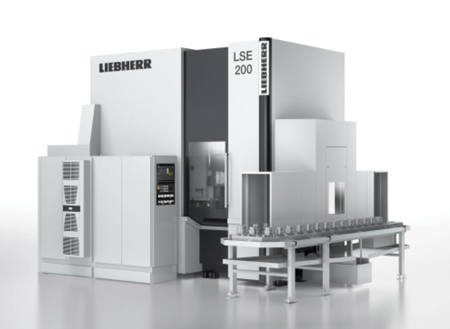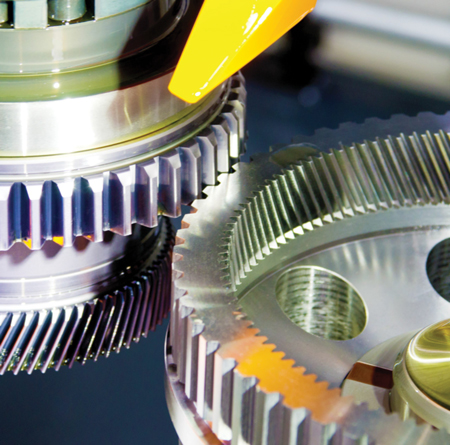Liebherr Gear Technology is introducing a smaller shaping head option, which facilitates electronically controlled machining of spur and helical gear teeth, at Gear Expo Booth #1809 for Platform 2 (LSE/LFS 200 to 500) and Platform 3 (LSE/LSF 600 to 1600) machines.
“The smaller SKE 120 shaping head enables users to machine a considerably wider range of components on our Platform 2 and Platform 3 gear-shaping machines,” said Dr. Hansjörg Geiser, manager of development and design for gear cutting machines at Liebherr-Verzahntechnik GmbH, regarding the new shaping head for the LFS/LSE range of gear shaping machines. “We are thus better able to meet contract manufacturers’ gear cutting requirements.”
The new SKE 120 shaping head with its highly dynamic rotary drive and moveable shaping head slide occupies less space at a stroke length of 120 mm. The design engineers used the gained space to enlarge the stroke position travel range on Platform 2 machines. The SKE 120’s stroke position travel range at 650 mm on Platform 2 machines is more than twice as large as that of the 300-mm SKE 240. The same applies to Platform 3 machines where the difference is 350 mm. Even 900 mm are feasible if raised column slides are used. The shaping spindle is hydrostatically mounted and channeled.
Some workpieces require a longer stroke length (for wider teeth), while others require a wider stroke position travel range (longer workpieces with correspondingly higher gear teeth). The optionally available NC swivel column slide, which lets you produce conical gear teeth at a shaping spindle angle of between -1° and +12°, has been optimized to achieve a higher degree of rigidity. If NC swivel column slides are not used, the shaping spindle angle can be adjusted by up to +/- 0.45° using a cam.
The direct-drive electronic lead guide provides users with latitude and flexibility. They only need to enter a helix angle of between 0° and 45° and the control system calculates the rest. The new SKE 120 shaping head differs primarily from the larger shaping head with electronic lead guide, SKE 240, by a smaller stroke length, hence the name. The crank drive features automatic mass counterbalance, which ensures optimum concentricity. The spindle itself has a somewhat narrower design than the SKE 240, which has a positive impact on interference conditions.
 High degree of flexibility
High degree of flexibility
SKE 120 and SKE 240 shaping heads featuring the electronic lead guide provide contract manufacturers with a range of new opportunities. For example, frequent workpiece changeovers are easier.
To be able to machine different helix angles on gears, the motion of the shaping head must replicate the gear’s helix angle. This can be performed by a mechanical lead guide. A manual changeover from mechanical lead guides becomes obsolete. Setup times are shortened because where an electronic lead guide is used only the shaping tool needs to be changed, if at all.
An added benefit is that customers do not have to invest in multiple lead guides. Furthermore, they are not dependent on the control’s processing time, which makes them even more flexible. Added opportunities are provided in combination with the stroke position adjustment detail.
High number of strokes, highly productive
A further requirement was the ability to manufacture efficiently and to optimum quality, in addition to the flexible range of workpieces. Therefore, the process itself is productive, given the high number of strokes at 1,200 double strokes per minute. This unique figure is based on a highly dynamic drive mechanism combined with effective control technology at optimum rigidity.
 Wide range of options
Wide range of options
Liebherr developed its Type LSE range of machines based on its proven LFS machines. Besides the option of using electronic lead guides, these machines also enable you to correct helix angles. Tooth flank angular deviation (fh) can be corrected simply and precisely when setting up the shaping machine.
Furthermore, it is possible to retain the helix angle for subsequent tempering. For even better quality, μm corrections can be done: the machine achieves tooth flank quality grade 4 as per DIN3962-2.
Along with increased quality and flexibility requirements, materials have also changed. For example, the tensile strength of workpieces to be shaped has increased substantially. The LFS/LSE machines have been designed to shape high-strength materials.
Liebherr has already applied the results of internal tests in this segment using appropriately configured and coated replaceable cutting inserts to industrial applications and put these in practice. The choice of high-alloy substrates with correspondingly efficient coatings demonstrates that machining performance and tool service lives can be enhanced.


















